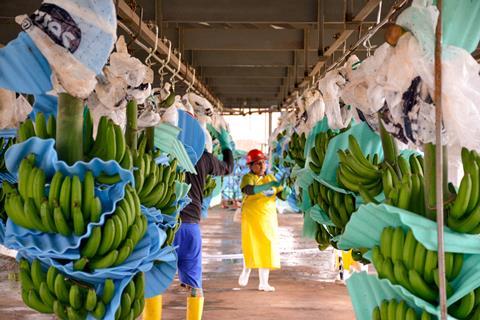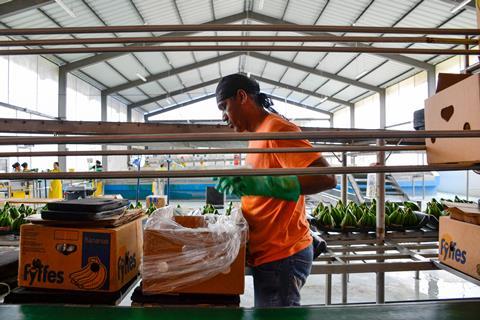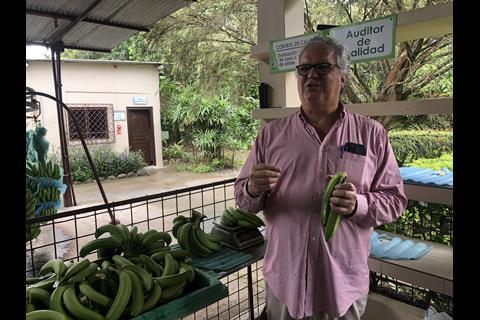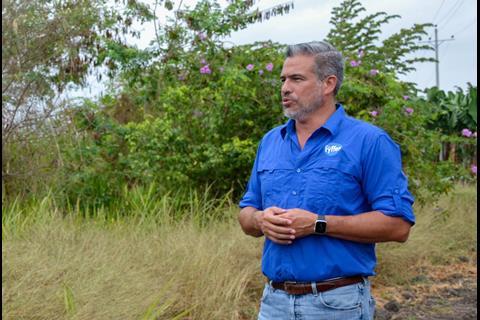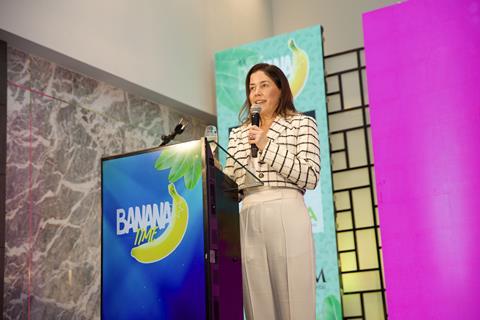Ecuador’s banana industry faces serious challenges around security and climate change, but hopes are high in the sector following the election of President Daniel Noboa, heir to one of the country’s largest exporters of the fruit. Fred Searle reports from Ecuador
In more ways than one, the Ecuadorean banana industry now finds itself at a crossroads. On the one hand, this is a time of great promise: 36-year-old Daniel Noboa, the son and heir of banana magnate Alvaro Noboa, was recently elected president, raising hopes the government will prioritise the interests of the sector.
Meanwhile, banana exports are on the up, rising by 6.4 per cent year on year in January-October 2023, as trade recovers from the disruption caused by container shortages, higher freight rates, disruption to shipping services, and the war in Ukraine.
Encouragingly, the sector is also making good progress on workers’ rights and pay, recently taking steps to formalise compliance with the national living wage and setting an example for other banana-producing nations to follow.
On the flip side, there are major security concerns – and in some respects, the risks for producers and exporters have never been greater. The trade finds itself at the centre of Ecuador’s well-documented problems with gang violence. Indeed, containers of bananas have been a major target for cocaine trafficking, making contamination, lost shipments, and personal safety a big concern.
In addition, El Niño is making production increasingly unpredictable due to flooding and associated pests, with Agroban president Leonidas Estrada predicting big crop losses if the damaging weather phenomenon manifests at full capacity.
And there were reports from exporter association Acorbanec in December that European retailers were reluctant to sign supply contracts that support the new ‘minimum support price’ of a box of Ecuadorean bananas, which has risen from US$6.50 in 2023 to US$6.85 in 2024.
Marianela Ubilla, president of the Association of Ecuadorean Banana Exporters (AEBE), kicked off the Banana Time convention in Guayaquil at the end of October with words of both hope and warning. “This product shows an increase of seven per cent in export volume and 18 per cent in FOB dollars compared to the same period in 2022, which shows that today more than ever, it is time for Ecuadorean bananas. However, we must remain alert.
“Our main markets are facing inflation, which could reduce the purchasing and consumption capacity of bananas in international markets. In addition, there are multiple challenges that the sector must continue to face, especially in terms of security, climate change, phytosanitary protection and the use of trade agreements.”
Business first
Although by no means the biggest, Fyffes is now a major banana producer in Ecuador, having set up its own production in the country 12 years ago. Prior to that, the supplier had exported bananas from other Ecuadorean growers, but today it also grows roughly 1,200ha of its own organic bananas on the Santa Elena peninsula near Guayaquil.
Leslie Medina, Fyffes’ banana production general manager, says he is “very happy” with the election of Noboa, Ecuador’s youngest-ever president, thanks to his business and family background. At the age of 18, Noboa created his own events company before joining the family business, Noboa Corporation, and holding management positions in shipping, logistics and commercial divisions.
The new president has said he would prioritise job creation through tax incentives and credit facilities to help small businesses, as well as vowing a “firm hand” against drug gangs and the “militarisation of ports and borders”.
“We can expect a more business-oriented policy that facilitates investment, growth and employment,” says Medina. “In particular, it would be nice to see the government invest more in communications, road infrastructure and bridges in rural areas – to help facilitate business. This would be especially helpful during the rainy season when wet weather can block access to farms.”
Weather worries
On this note, the growing threat of El Niño is a hot topic following forecasts in July 2023 that flooding and droughts, intensified by climate change, could cost South America’s economies an estimated US$300bn. For the Ecuadorean banana sector specifically, the main fear is that heavy rainfall due to climate change can harm banana crops in three ways – by causing physical damage to plants, by harming the ripening process, and by increasing the prevalence of diseases such as black sigatoka, which can lead to significant crop losses.
More than 70 per cent of Ecuadorean growers say they have already seen climate change have a major impact on their farms, and climate impacts are estimated to have reduced producers’ incomes by 15.7 per cent on average over the past two years. Banana growers in the south have been especially hard hit, and back in July it was estimated that El Niño could cause the loss of up to 50,000ha of banana plantations. This is equivalent to 1,365,000 tonnes (worth almost $600m) in lost exports.
Supermarket strategy
The other big talking point is price, and it will come as no great surprise that there has reportedly been kickback from European supermarkets on the minimum price set for a box of Ecuadorean bananas in 2024.
Indeed, in 2022 Rabobank’s fresh produce expert Cindy Van Rijswick gathered data from the UK’s Office for National Statistics to reveal that retail prices for bananas in Britain were still below the level seen in 1987 – despite inflation and decades of rising costs and sustainability requirements for banana producers around the world.
“Bananas have a big problem,” Marcel Laniado of Machala-based banana producer La Nueva Pubenza told FPJ. “They are the commodity that supermarkets all over the world compare to see who has the lowest price. They are one of the core items in the basic food basket.
“If you increase the price of bananas by just US$0.60 per box, that is a huge amount of money for the farmer. But it would only add up to a tiny increase for the consumer. The shopper wouldn’t even notice this increase. But we have a problem with supermarkets’ commercial strategy.
“In my view, the problem isn’t the margin that each player in the supply chain is making. There are huge risks for exporters, so it is understandable that they make a 20 per cent margin, or whatever it may be. Likewise, retailers have big overheads, and they need to cover the costs of their stores. But if the retail price was increased only slightly, it would make the whole supply chain more stable and sustainable.”
Price potential
Growers’ costs have increased significantly in recent years, not only due to inflation, but also due to the huge certification burden and rising wage bills. The impact of unsustainable retail prices on Ecuadorean banana producers was highlighted in April 2022 when growers from three provinces blocked main roads to demand government action to boost prices that they said were too low to cover the cost of production.
Richard Salazar, executive director of Acorbanec, emphasised at Fruit Attraction 2023 that the matter of living wages in Ecuador cannot be discussed separately from the issue of a fair price for bananas. He said: “Retailers have the chance to show commitment to a true shared responsibility”, adding that this requires “long-term contractual engagements on the volume of products, based on fair prices”.
Aldi’s commitment in August 2022 to consider the cost factors underpinning the Fairtrade Minimum Price when setting its retail prices was certainly a step in the right direction. But given all the pressures and uncertainty facing supply chains at the moment, the sector needs better long-term support from the value chain.
Fyffes’ business development manger Michaela Schneider insists that consumers would be willing to pay more for bananas, pointing to research published last year which showed that consumers in six countries – the US, Canada, the UK, Ireland, Germany and the Netherlands – think the fruit is cheap and accessible.
“When you asked them what kind of price they pay for bananas, they overestimated the price and still thought it was cheap,” she says. “Around two thirds are willing to spend more for a banana that is certified as being organic or Fairtrade.”
